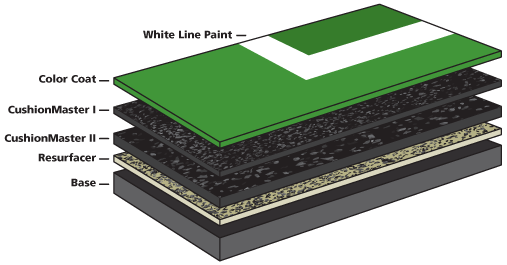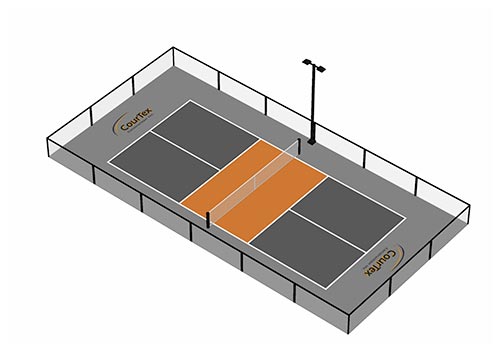Indoor and Exterior Pickleball Court Construction Solutions
Indoor and Exterior Pickleball Court Construction Solutions
Blog Article
Sustainable Practices in Pickleball Court Building And Construction You Ought To Know
As the appeal of pickleball continues to rise, so as well does the demand for lasting practices in court building and construction. The impact of these practices expands much beyond the court itself.
Picking Eco-Friendly Materials
Picking green materials is a vital step in the building and construction of lasting pickleball courts. The selection of lasting products not just decreases environmental effect yet additionally boosts the long life and performance of the court. Secret materials consist of reused rubber for the surface area, which uses excellent longevity and shock absorption while diverting waste from landfills.
Additionally, using locally sourced materials decreases transport discharges and sustains regional economies. Pickleball court construction. Utilizing native woods for fencing and seating can offer a lasting visual while making sure resilience against the aspects.
Integrating absorptive products for court structures can even more contribute to sustainability by permitting all-natural water drain and lowering overflow. These options not only protect neighborhood ecosystems however also advertise healthier play environments.
Reliable Drain Solutions
While the choice of eco-friendly materials is necessary, carrying out efficient drain remedies is just as important for keeping sustainable pickleball courts. Proper water drainage not just safeguards the court surface from water damage but also minimizes erosion and overflow, promoting ecological stability.
Reliable water drainage systems can consist of permeable paving, which permits water to infiltrate the ground instead of pooling externally. This reduces the likelihood of standing water, which can bring about mold and other upkeep problems. In addition, integrating purposefully put water drainage networks and swales can direct excess water far from the court location, making sure a completely dry playing surface and stopping soil erosion.
Utilizing native greenery in the landscape design around the courts can better enhance drainage by absorbing excess water and decreasing overflow. These plants need much less watering and promote biodiversity, lining up with sustainable practices.
In addition, it is important to consistently preserve the water drainage system to guarantee its long-term efficiency. This consists of clearing particles and surveillance for clogs. By prioritizing effective drain solutions, pickleball court producers can substantially contribute to the sustainability and long life of the center, inevitably profiting both players and the atmosphere.
Energy-Efficient Lights Options
As the demand for pickleball proceeds to grow, incorporating energy-efficient illumination alternatives into court design has come to be progressively essential for sustainability. Standard lights systems frequently consume extreme power, adding to higher functional costs and ecological influence. Adopting modern, energy-efficient innovations is crucial for both new buildings and renovations.
LED (Light Emitting Diode) lighting attracts attention as a top choice as a result of its longevity and energy savings (Pickleball court construction). Compared to traditional illumination, LEDs utilize approximately 75% less energy and can last approximately 25 times longer, substantially lowering upkeep expenses. Furthermore, the directional nature of LED illumination reduces light air pollution, ensuring that illumination is concentrated on the court instead than surrounding areas.

Lasting Surface Area Alternatives
Discovering lasting surface choices for pickleball courts internet has gotten grip among gamers and home builders alike. The emphasis on eco-friendly materials not only lines up with the expanding environmental understanding however likewise improves the efficiency and durability of the courts.
One popular choice is using recycled rubber, which can be sourced from made use of tires. This material gives exceptional shock absorption, minimizing the danger of injuries for players while promoting sustainability. Additionally, modular floor tiles made from recycled plastics offer an additional practical option. These ceramic tiles are very easy to set up and replace, and their versatility allows for numerous court setups.
Natural turf courts are likewise arising as a sustainable selection, promoting biodiversity and reducing the heat island result. They call for normal upkeep and water, which may not straighten with all sustainability goals.

Water Conservation Strategies

One more reliable method includes the installation of rain harvesting systems. These systems collect and save rainwater for use in maintaining court surface areas and landscaping. This approach not just preserves check out here drinkable water however also minimizes reliance on metropolitan sources.
Moreover, utilizing drought-resistant landscape design around the courts is essential. Indigenous plants require much less water and are much better adapted to regional environment problems, thus decreasing general water consumption. Furthermore, making use of efficient irrigation systems, such as drip watering, makes certain that water is delivered straight to plant roots, lessening dissipation and waste.
Conclusion
Incorporating lasting practices in pickleball court building and construction considerably adds to environmental conservation and resource effectiveness. By focusing on these techniques, the building and construction of pickleball courts can align with more comprehensive ecological goals while advertising longevity and performance within areas.
As the popularity of pickleball continues to climb, so too does the requirement for lasting techniques in court building.Selecting eco-friendly materials is a critical step in the building of sustainable pickleball courts. By focusing on energy-efficient lights options, pickleball court fitters can add to a much more sustainable future while satisfying the requirements of stakeholders and players alike.Integrating lasting surface alternatives not just boosts the efficiency of pickleball courts yet additionally leads the method for carrying out reliable water conservation techniques.Incorporating lasting methods in pickleball court building considerably contributes to ecological preservation and resource performance.
Report this page